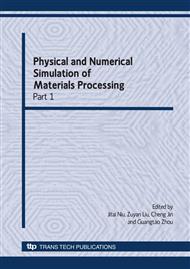p.328
p.334
p.340
p.345
p.350
p.356
p.367
p.373
p.379
A Method of Bulge Test for Determining the Work Hardening Characteristics of Sheet Metals
Abstract:
The bulge test has many advantages such as large deformation range and facility of loading. But the curvature and thickness of specimens are varied at different positions of meridian, and changed with the loading, so it's quite difficult to acquire the true stresses and true strains. Fixed attention on the crown of specimens, this paper put forward an improved method of bulge test. 3D coordinates of grid points on the surface of specimens are measured on each sub-step of loading by universal toolmaker’s microscope, and then the curvatures and in-plane strains at the crown can be acquired. The influence of springback on the curvatures at the crown is taken into account using finite element methods based on MITC4 (mixed interpolation of tensorial components) shell element. Thus the relationships between equivalent stresses and strains may be established, which integrally represents the work hardening characteristics of sheet metals. Bulge tests had been done on 316L austenite stainless steel.
Info:
Periodical:
Pages:
350-355
Citation:
Online since:
April 2008
Authors:
Price:
Сopyright:
© 2008 Trans Tech Publications Ltd. All Rights Reserved
Share:
Citation:


